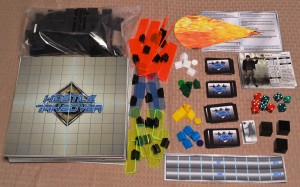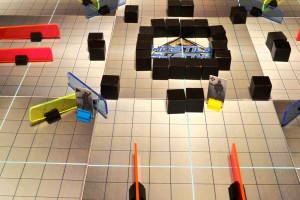There’s something to be said for the complexity of tactical simulators. While my busy lifestyle doesn’t always entertain games that take a while to learn and play, I sometimes come across a few that have depth but are still relatively easy to pick up. “Hostile Takeover” has the characteristics of a deep and strategic experience, but manages to remain what my fellow gamers in the video game industry call “noob-friendly”. Before we get started, I’d like to thank Andrew McGrady from Not Dead Yet Games for reaching out and providing me with a press copy. It’s important to stress that because the game is still in the process of being funded through Kickstarter, that the rules and contents featured below are subject to change.
“Hostile Takeover” is more than just a game, it’s a template for folks to try out different scenarios. I’ve played a few tactical simulators back in my day so this is really nothing new, though I am pleased to report that this game is simpler than most. My press copy came with a nine game boards, each comprised of a 10×10 square grid, that serves as the battleground for all of the scenarios in which players can embark. I also received a set of mini cardboard stand-ups that represent the troops that players will be controlling during the battle. Action cards will provide the tools your troops will need to…you guessed it, perform certain actions. Where action cards give players ways to command their units, energy tokens can buff them in various ways. Six and eight-sided dice round out the lot, which are used for initiative rolls, combat, and the like.
In addition to the components I mentioned above, my copy also came with various obstacles and terrain features in the form of barrier cubes and force fields. These items are set up in a particular way, depending on the scenario being played. With that being said, players are free to place them wherever they wish. Again, feel free to experiment since games like this usually allow for it. These terrain modifiers have an effect on how protected a particular unit is in combat (cover)…needless to say, you’ll want to keep your units behind something if at all possible. Speaking of units, each character in the game has their own character card and unique attributes to match. This appealed to my inner-child in a way, as I could draft my own team as I saw fit. Finally, the game includes a score track and some tokens just so that players won’t have to keep score via a pencil and paper.
So what exactly is the goal of this game? It’s actually pretty simple…the player who manages to earn more victory points or complete a particular objective wins the game. These requirements will change, depending on the type of scenario you play. At the beginning of the game, each player will be given (or choose) four mercenaries to command. It’ll be up to the players to use them in the most efficient manner possible so that they can complete objectives and earn victory points. I like how the game is flexible enough to do away with the special objectives, if all you’re looking to do is duke it out with a friend. I have to admit however that including special objectives makes the game a tad more interesting.
The game is played over a series of rounds, with all players going at the same time. At the beginning of a round, players will assign an action card to all non-wounded troops. Players will also need to assign four energy tokens as they see fit. At this point, every player rolls for initiative and uses the cards/tokens they’ve played to factor in the values accordingly. In initiative order, players resolve their actions. Once this is accomplished, the round ends after a brief clean-up phase. This continues until one player manages to complete an objective or the victory point threshold has been met. Pretty simple, right? Sort of.
Combat, range, and cover come into play during these phases and have a direct impact on how well a particular unit will fare when pitched in the heat of battle. There’s also melee and ranged combat to consider, as both factor in values from different places. Melee combat factors in weapons and the target’s action & status, while ranged combat factors in weapons, cover, and the target’s action. This is where the learning curve can get a bit dicey, as it may take a game or two to recognize which circumstances are affected by what values. Luckily, the game isn’t THAT complex to where you’ll be scratching your head trying to figure out a resolution for hours on end. After all, combat is really just a value check after rolling a set number of dice…the initial challenge is just factoring in the modifiers.
At its core, “Hostile Takeover” is an excellent introductory game that will serve to get players interested in the genre as a whole. It’s not as complex as some of the other games I’ve covered in my travels, but complexity doesn’t always determine how fun a game is to play. For those of you who enjoy light tactical simulators that still offer a fairly decent amount of gameplay, “Hostile Takeover” is the game of choice. Lighter tactical simulators also have the luxury of being played in about an hour or two…I can think of a few that take three or four hours to play if you really get into them. Parental guidance is suggested, not for the gore or violence (there really is none worth mentioning), but for the learning curve associated with the ins and outs of tactical simulators in general. At the very least, it’s worth checking out!
—
You can learn more about and support “Hostile Takeover” by visiting the following websites:
http://www.kickstarter.com/projects/1344486816/hostile-takeover
http://notdeadyetgames.com/hostile-takeover/
https://www.facebook.com/NotDeadYetGames
—


